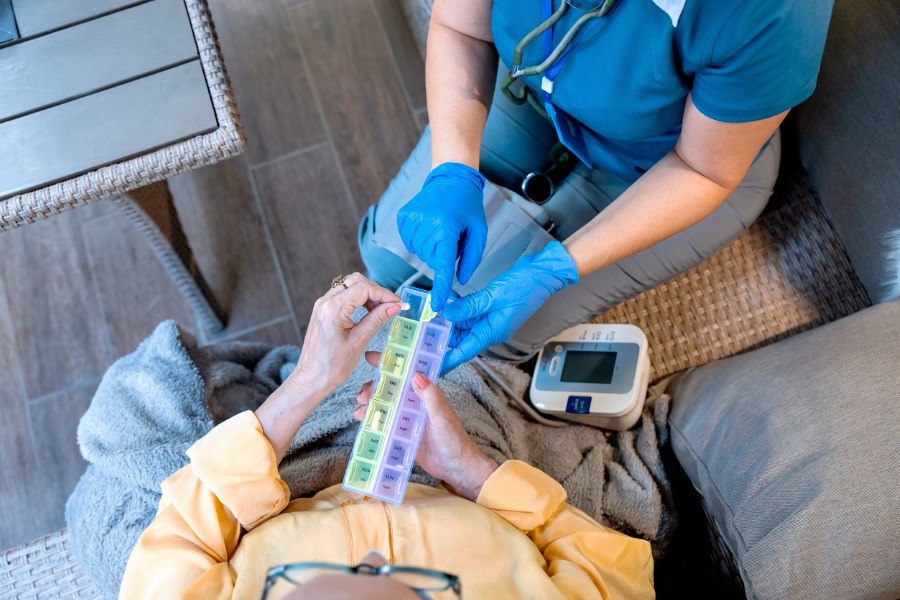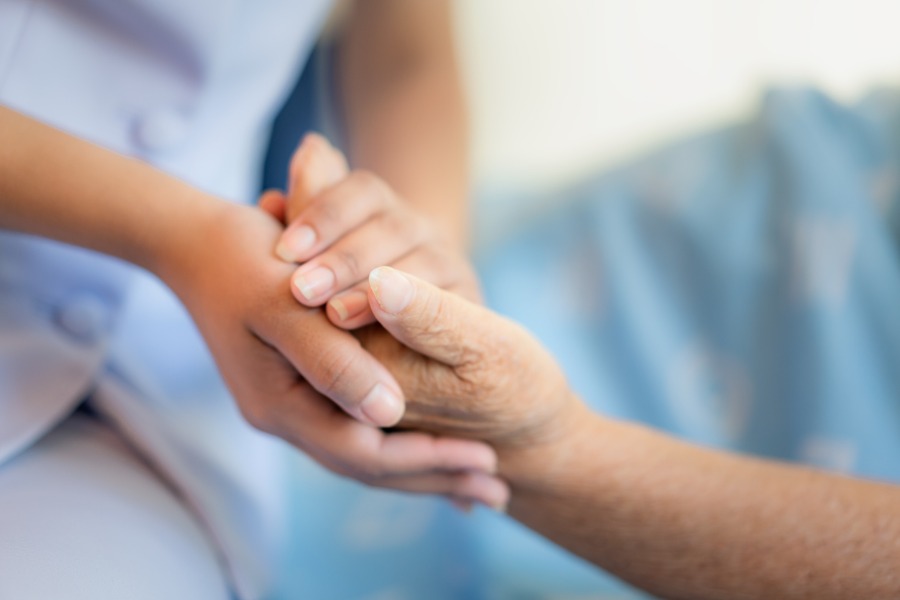
As we reach the end of November, we reflect back on a month of cooler weather, holidays, and exciting preparation for the new year. However, November is also committed to bringing awareness to one of the most common cancers in the U.S. — lung cancer.
If you’re living with lung cancer, the right care team, a properly developed care plan, and a positive mindset can really make a difference. You can focus on living life free from pain and surrounded by loved ones, no matter which stage of the illness you’re in. So, let’s take a look at the types of lung cancer, who’s at risk, the importance of early detection, and how to live comfortably with this diagnosis.
Types of Lung Cancer

The Centers for Disease Control and Prevention (CDC), recognizes lung cancer in two forms: small cell and non-small cell. Both types originate in the lungs, however, they spread differently and are treated differently. Non-small cell is more common, however, 95% of people diagnosed with small cell lung cancer are smokers.
What to know about non-small cell lung cancer:
- There are many types of non-small cell lung cancer, including squamous cell carcinoma, large cell carcinoma, and adenocarcinoma.
- Smoking can greatly influence a non-small cell lung cancer diagnosis.
- A biopsy can determine this type of cancer.
- Symptoms include shortness of breath and a continuous cough.
What to know about small cell lung cancer:
- Small cell lung cancer is made up of two main types: small cell carcinoma and combined small cell carcinoma.
- Smoking is the major risk factor.
- Doctors identify small cell lung cancer with a chest X-ray, CT scan, or a bronchoscopy.
- In addition to shortness of breath and coughing, symptoms also include trouble swallowing, chest pain, and loss of appetite.
Who’s at Risk of Lung Cancer?

Now that we’ve looked at types of lung cancer, the symptoms, and how it’s diagnosed, let’s look at the most at-risk communities for lung cancer.
Smokers
- Cigarette smoking is the number one leading cause of lung cancer, and smokers are 15 to 30 times more likely to be diagnosed compared to non-smokers.
- Not only does smoking increase your risk of cancer, but it can also increase the risk to those around you. Secondhand smoke is the cause of an estimated 53,000 additional deaths in the U.S. each year. The toxins from the burning end of the cigarette combined with the exhaled smoke itself can poison others with more than 7,000 chemicals.
- For your sake and for the loved ones around you, if you smoke, make it a priority to quit smoking.
Veterans
- Servicemen and women are another at-risk community for lung cancer due to the potential for toxic exposures on bases. Across the United States, select military bases are discovering that the air, groundwater, and surrounding sediments are at risk of contamination due to chemicals used during training exercises.
- As a result of these exposures, numerous veterans have developed health complications in their lungs. Aside from small cell and non-small cell lung cancers, mesothelioma is a specific and rare form of cancer. It is commonly found in the lining of the lungs. Prolonged or repeated exposures to asbestos, which has been identified as one of the contaminants found on military bases, causes this.
- Because of this, veterans need to be adamant about attending doctors’ visits and monitoring any abnormal changes in their health.
- Veterans who are living with lung cancer benefit from a well developed and personalized plan of care. It must consider the unique needs tied to their past service.
Family history
- Even for non-smokers, there’s still a risk of lung cancer due to genetics and family history.
- Having parents or siblings with a form of lung cancer can put you at a higher risk of developing cancer yourself. Additionally, if you’ve already had a form of lung cancer, you’re at a higher risk of developing a different form of lung cancer.
- Make sure to inform your doctor about any family cancer history. This ensures proper screening and increases your chances of early detection.
The Importance of Early Detection

Speaking of early detection, this is one of the most crucial factors in any cancer diagnosis. According to the Lung Cancer Foundation of America (LCFA), early detection of lung cancer increases a patient’s five-year survival rate from 18% to 55%. That’s more than doubling your chances of recovery, which is worth the early screenings.
Early detection also allows you to seek care, navigate your options, build your support team, and start treatments as soon as possible. Lung cancer treatments include:
- Surgery- depending on the amount of affected tissue, undergoing surgery to remove the cancer can be an option in certain cases.
- Radiation therapy – using targeted radiation (similar to X-rays) to kill cancer cells.
- Chemotherapy – having regular medicinal treatments either by pill or IV to kill the cancer.
- Targeted therapy – this is another medicinal treatment that aims to stop the spread and growth of the cancer cells.
Palliative Care for Lung Cancer

In this stage, it’s incredibly important to focus on your health and eliminate added stressors. Managing any pain or discomfort associated with your treatments makes it easier to continue with them and toward your goals. That’s why palliative care is a great choice for individuals facing a serious illness like lung cancer. This specialized care provides you with a dedicated staff of healthcare professionals.
The comfort care team helps you navigate treatment options, find relief from pain and uncomfortable symptoms or treatment side effects. Your palliative care team also creates an advanced care plan to meet your needs today and prepare for potential outcomes and decisions that tomorrow may bring. You’ll be able to remain independent at home while continuing to seek treatment and visit specialists. Palliative care provides the care and support you need and helps to make this diagnosis more comfortable.
Hospice for Lung Cancer

For those who have progressed to end-stage lung cancer and no longer desire or benefit from treatments, the most important thing is to stay comfortable and remain close to the people you love. In these final weeks or months hospice care empowers you to continue living each day to the fullest. Not only will you have medical professionals assisting with pain management, but will benefit from the spiritual, emotional and physical support that the hospice care team offers.
Family caregivers will benefit from receiving the support, training and guidance they need. Spend your time focused on making memories with the people you love. It will also comfort you to know that your family will receive hospice bereavement support once you’ve passed.
Hospice care provides patients with:
- Individualized care plans based on conversations with your physician.
- Case management support from a Registered Nurse.
- Pain management to help you live every day comfortably.
- Emotional healing to help come to terms with your diagnosis.
- Spiritual advisor to help find peace, comfort and closure.
Whatever stage of lung cancer you’re in, Salus Homecare is here to help make living with this diagnosis more comfortable. Our care managers can answer your questions, walk you through care plan options, and help find the best-individualized care for you. As your needs change, our continuum of care ensures you always benefit from the right level of support.
Contact us today to learn more about our palliative care, hospice, and other home health services. Let’s work together to help you enjoy a higher quality of life while living with lung cancer.

